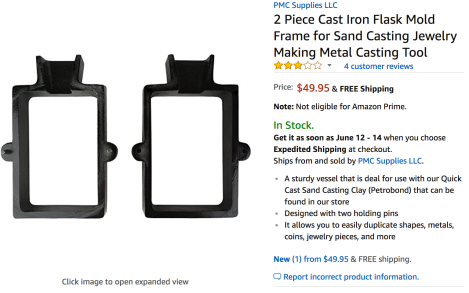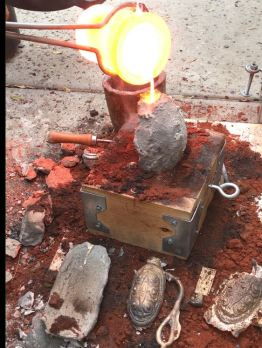While there are a dozen ways to go about sand casting, listed below are materials for getting into reliable and safe sand casting easily!
- The Sand: there are many recipes for making ‘oiled’ sand (the oil holds the sand together), but home-made recipes that create fine casts require very fine sand and the oil itself is perishable very quickly from heat and use. For those of us with limited time and money, I recommend hitting Amazon.com up for some “Petrobond.” You can buy this in various quantities; for pewtering in a fairly small mould frame (flask), I find that 10lbs at a time are more than enough for lots of casting. Many can do with less.
- The flask (frame mould)
- There are two ways to go about a casting frame (also known as a flask). One way is to go build one by using thick simple wooden picture frames from craft stores, or buying wood and simply building a frame. Doing so is fine for pewter-casting, as the metal being poured in will not hurt the wooden frame at all. (More details to come later regarding building a frame).
- If you are also planning on brass/bronze/silver/gold/aluminum casting, go get yourself a good iron or steel flask. It is nice when you have something that won’t catch itself on fire from residual heat. I LOVE this one from Amazon (great for most smaller – medium sized items, such as pilgrim’s badges or thor’s hammers, etc). I use it for pewter very often as well, because it simple works nicely and travels well.

**Note: For bronze casting larger items, such as Gotlandic Viking brooches, I do have a larger wooden frame made from thick 2×4’s. Yes, it burns a bit from residual heat when I pour the bronze in, but it is cheaper than having a metal frame welded together and works well when used carefully. (Pics to come).
3. Graphite or Talc powder. Baby powder works, or Amazon up some powdered graphite. I personally like graphite because I use it for tons of other stuff and have a lot laying around. This is what you use to A: coat the item you are making a copy of so it does not stick in the sand and can be extracted easily after making an impression and, B: for coating the two facing sides of sand that are being pressed together before pouring the metal in, so you can separate the sides easily later. More will be discussed on this process in our demonstration at 40 Year, and images will be added here soon.
Beyond these items, everything else you already have from stone-casting pewter will be part of your kit as well.
